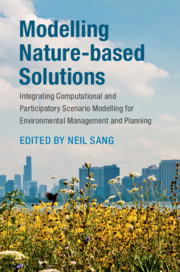 Modelling Nature-based Solutions
Modelling Nature-based Solutions Book contents
- Modelling Nature-based Solutions
- Modelling Nature-based Solutions
- Copyright page
- Contents
- Contributors
- Foreword
- Acknowledgements
- Introduction
- 1 Landscape Modelling and Stakeholder Engagement: Participatory Approaches and Landscape Visualisation
- 2 Agent-based Models of Coupled Social and Natural Systems
- 3 Modelling Nature-based Solutions from Soil Ecosystem Services
- 4 Modelling Water Resources for Nature-based Solutions
- 5 Models at the Service of Marine Nature-based Solutions
- 6 Coastal and Freshwater Flood Models: A Review in the Context of NBS
- 7 Nature-based Solutions to Urban Microclimate Regulation
- 8 Data Mining, Machine Learning and Spatial Data Infrastructures for Scenario Modelling
- 9 Can Geodesign Be Used to Facilitate Boundary Management for Planning and Implementation of Nature-based Solutions?
- 10 Integrating Models into Practice – Recommendations
- Appendix: List of Models/Software
- Index
- Plate Section (PDF Only)
- References
1 - Landscape Modelling and Stakeholder Engagement: Participatory Approaches and Landscape Visualisation
Published online by Cambridge University Press: 13 March 2020
- Modelling Nature-based Solutions
- Modelling Nature-based Solutions
- Copyright page
- Contents
- Contributors
- Foreword
- Acknowledgements
- Introduction
- 1 Landscape Modelling and Stakeholder Engagement: Participatory Approaches and Landscape Visualisation
- 2 Agent-based Models of Coupled Social and Natural Systems
- 3 Modelling Nature-based Solutions from Soil Ecosystem Services
- 4 Modelling Water Resources for Nature-based Solutions
- 5 Models at the Service of Marine Nature-based Solutions
- 6 Coastal and Freshwater Flood Models: A Review in the Context of NBS
- 7 Nature-based Solutions to Urban Microclimate Regulation
- 8 Data Mining, Machine Learning and Spatial Data Infrastructures for Scenario Modelling
- 9 Can Geodesign Be Used to Facilitate Boundary Management for Planning and Implementation of Nature-based Solutions?
- 10 Integrating Models into Practice – Recommendations
- Appendix: List of Models/Software
- Index
- Plate Section (PDF Only)
- References
Summary
Landscapes are defined as ‘an area, as perceived by people, whose character is the result of the action and interaction of natural and/or human factors’ (Council of Europe, 2000). Cultural landscapes are defined by the UNESCO World Heritage Convention (1992) as distinct geographical areas or properties uniquely ‘represent[ing] the combined work of nature and of man’. It also describes cultural landscapes as a ‘diversity of manifestations of the interaction between humankind and its natural environment’, and that the protection of traditional cultural landscapes can contribute to maintaining biological diversity. Indeed, Pilgrim and Pretty (2010) propose that the resilience of ecocultural systems is at its strongest when biological and cultural diversity can be considered as an interdependent whole.
- Type
- Chapter
- Information
- Modelling Nature-based SolutionsIntegrating Computational and Participatory Scenario Modelling for Environmental Management and Planning, pp. 19 - 55Publisher: Cambridge University PressPrint publication year: 2020
References
- 2
- Cited by
